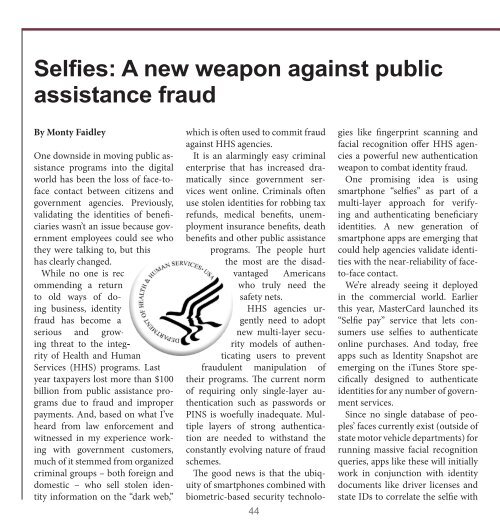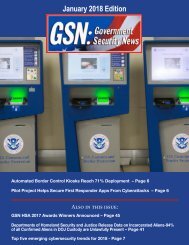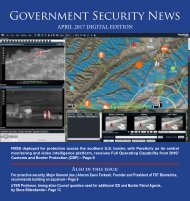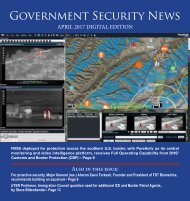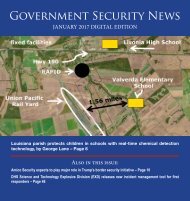GSN_Nov-Dec_FINAL_Yumpu
You also want an ePaper? Increase the reach of your titles
YUMPU automatically turns print PDFs into web optimized ePapers that Google loves.
Selfies: A new weapon against public<br />
assistance fraud<br />
By Monty Faidley<br />
One downside in moving public assistance<br />
programs into the digital<br />
world has been the loss of face-toface<br />
contact between citizens and<br />
government agencies. Previously,<br />
validating the identities of beneficiaries<br />
wasn’t an issue because government<br />
employees could see who<br />
they were talking to, but this<br />
has clearly changed.<br />
While no one is ommending a return<br />
recto<br />
old ways of doing<br />
business, identity<br />
fraud has become a<br />
serious and grow-<br />
ing threat to the integrity<br />
of Health and Human<br />
Services (HHS) programs. Last<br />
year taxpayers lost more than $100<br />
billion from public assistance programs<br />
due to fraud and improper<br />
payments. And, based on what I’ve<br />
heard from law enforcement and<br />
witnessed in my experience working<br />
with government customers,<br />
much of it stemmed from organized<br />
criminal groups – both foreign and<br />
domestic – who sell stolen identity<br />
information on the “dark web,”<br />
which is often used to commit fraud<br />
against HHS agencies.<br />
It is an alarmingly easy criminal<br />
enterprise that has increased dramatically<br />
since government services<br />
went online. Criminals often<br />
use stolen identities for robbing tax<br />
refunds, medical benefits, unemployment<br />
insurance benefits, death<br />
benefits and other public assistance<br />
programs. The people hurt<br />
the most are the disad-<br />
vantaged<br />
Americans<br />
who truly need the<br />
safety nets.<br />
HHS agencies ur-<br />
gently need to adopt<br />
new multi-layer secu-<br />
rity models of authen-<br />
ticating users to prevent<br />
fraudulent manipulation of<br />
their programs. The current norm<br />
of requiring only single-layer authentication<br />
such as passwords or<br />
PINS is woefully inadequate. Multiple<br />
layers of strong authentication<br />
are needed to withstand the<br />
constantly evolving nature of fraud<br />
schemes.<br />
The good news is that the ubiquity<br />
of smartphones combined with<br />
biometric-based security technolo-<br />
44<br />
gies like fingerprint scanning and<br />
facial recognition offer HHS agencies<br />
a powerful new authentication<br />
weapon to combat identity fraud.<br />
One promising idea is using<br />
smartphone “selfies” as part of a<br />
multi-layer approach for verifying<br />
and authenticating beneficiary<br />
identities. A new generation of<br />
smartphone apps are emerging that<br />
could help agencies validate identities<br />
with the near-reliability of faceto-face<br />
contact.<br />
We’re already seeing it deployed<br />
in the commercial world. Earlier<br />
this year, MasterCard launched its<br />
“Selfie pay” service that lets consumers<br />
use selfies to authenticate<br />
online purchases. And today, free<br />
apps such as Identity Snapshot are<br />
emerging on the iTunes Store specifically<br />
designed to authenticate<br />
identities for any number of government<br />
services.<br />
Since no single database of peoples’<br />
faces currently exist (outside of<br />
state motor vehicle departments) for<br />
running massive facial recognition<br />
queries, apps like these will initially<br />
work in conjunction with identity<br />
documents like driver licenses and<br />
state IDs to correlate the selfie with


